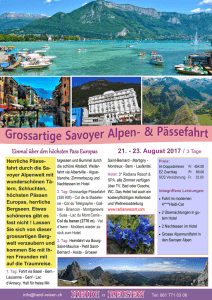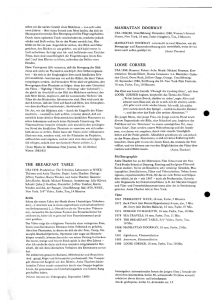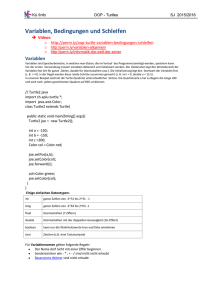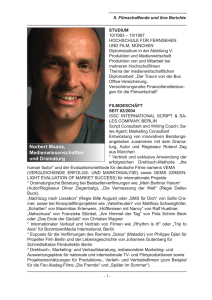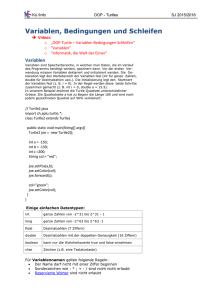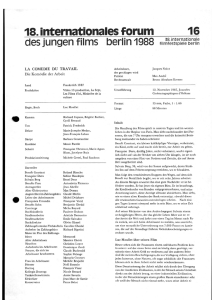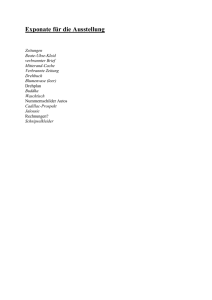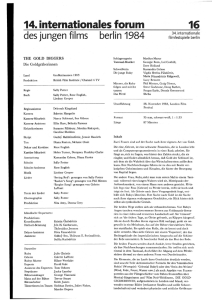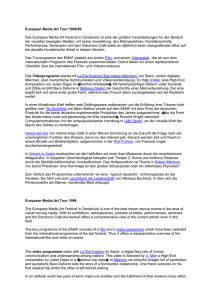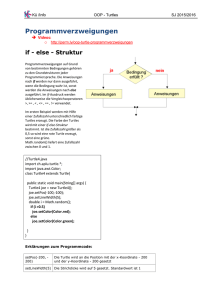European Media Art Tour 1999/2000
Werbung
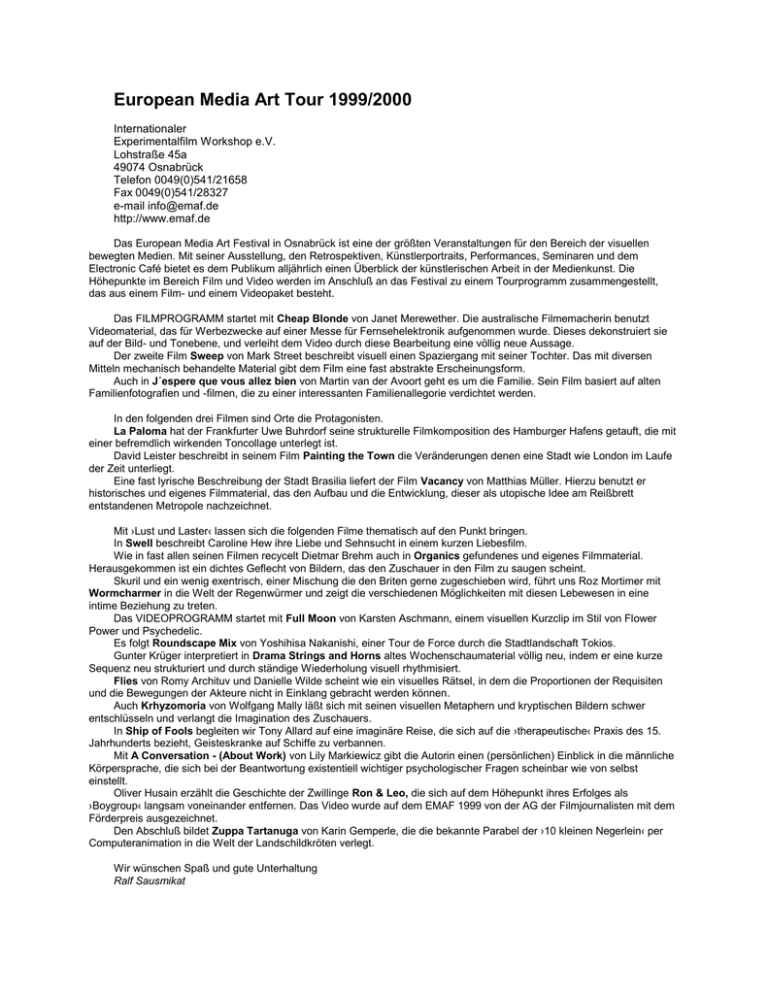
European Media Art Tour 1999/2000 Internationaler Experimentalfilm Workshop e.V. Lohstraße 45a 49074 Osnabrück Telefon 0049(0)541/21658 Fax 0049(0)541/28327 e-mail [email protected] http://www.emaf.de Das European Media Art Festival in Osnabrück ist eine der größten Veranstaltungen für den Bereich der visuellen bewegten Medien. Mit seiner Ausstellung, den Retrospektiven, Künstlerportraits, Performances, Seminaren und dem Electronic Café bietet es dem Publikum alljährlich einen Überblick der künstlerischen Arbeit in der Medienkunst. Die Höhepunkte im Bereich Film und Video werden im Anschluß an das Festival zu einem Tourprogramm zusammengestellt, das aus einem Film- und einem Videopaket besteht. Das FILMPROGRAMM startet mit Cheap Blonde von Janet Merewether. Die australische Filmemacherin benutzt Videomaterial, das für Werbezwecke auf einer Messe für Fernsehelektronik aufgenommen wurde. Dieses dekonstruiert sie auf der Bild- und Tonebene, und verleiht dem Video durch diese Bearbeitung eine völlig neue Aussage. Der zweite Film Sweep von Mark Street beschreibt visuell einen Spaziergang mit seiner Tochter. Das mit diversen Mitteln mechanisch behandelte Material gibt dem Film eine fast abstrakte Erscheinungsform. Auch in J´espere que vous allez bien von Martin van der Avoort geht es um die Familie. Sein Film basiert auf alten Familienfotografien und -filmen, die zu einer interessanten Familienallegorie verdichtet werden. In den folgenden drei Filmen sind Orte die Protagonisten. La Paloma hat der Frankfurter Uwe Buhrdorf seine strukturelle Filmkomposition des Hamburger Hafens getauft, die mit einer befremdlich wirkenden Toncollage unterlegt ist. David Leister beschreibt in seinem Film Painting the Town die Veränderungen denen eine Stadt wie London im Laufe der Zeit unterliegt. Eine fast lyrische Beschreibung der Stadt Brasilia liefert der Film Vacancy von Matthias Müller. Hierzu benutzt er historisches und eigenes Filmmaterial, das den Aufbau und die Entwicklung, dieser als utopische Idee am Reißbrett entstandenen Metropole nachzeichnet. Mit ›Lust und Laster‹ lassen sich die folgenden Filme thematisch auf den Punkt bringen. In Swell beschreibt Caroline Hew ihre Liebe und Sehnsucht in einem kurzen Liebesfilm. Wie in fast allen seinen Filmen recycelt Dietmar Brehm auch in Organics gefundenes und eigenes Filmmaterial. Herausgekommen ist ein dichtes Geflecht von Bildern, das den Zuschauer in den Film zu saugen scheint. Skuril und ein wenig exentrisch, einer Mischung die den Briten gerne zugeschieben wird, führt uns Roz Mortimer mit Wormcharmer in die Welt der Regenwürmer und zeigt die verschiedenen Möglichkeiten mit diesen Lebewesen in eine intime Beziehung zu treten. Das VIDEOPROGRAMM startet mit Full Moon von Karsten Aschmann, einem visuellen Kurzclip im Stil von Flower Power und Psychedelic. Es folgt Roundscape Mix von Yoshihisa Nakanishi, einer Tour de Force durch die Stadtlandschaft Tokios. Gunter Krüger interpretiert in Drama Strings and Horns altes Wochenschaumaterial völlig neu, indem er eine kurze Sequenz neu strukturiert und durch ständige Wiederholung visuell rhythmisiert. Flies von Romy Archituv und Danielle Wilde scheint wie ein visuelles Rätsel, in dem die Proportionen der Requisiten und die Bewegungen der Akteure nicht in Einklang gebracht werden können. Auch Krhyzomoria von Wolfgang Mally läßt sich mit seinen visuellen Metaphern und kryptischen Bildern schwer entschlüsseln und verlangt die Imagination des Zuschauers. In Ship of Fools begleiten wir Tony Allard auf eine imaginäre Reise, die sich auf die ›therapeutische‹ Praxis des 15. Jahrhunderts bezieht, Geisteskranke auf Schiffe zu verbannen. Mit A Conversation - (About Work) von Lily Markiewicz gibt die Autorin einen (persönlichen) Einblick in die männliche Körpersprache, die sich bei der Beantwortung existentiell wichtiger psychologischer Fragen scheinbar wie von selbst einstellt. Oliver Husain erzählt die Geschichte der Zwillinge Ron & Leo, die sich auf dem Höhepunkt ihres Erfolges als ›Boygroup‹ langsam voneinander entfernen. Das Video wurde auf dem EMAF 1999 von der AG der Filmjournalisten mit dem Förderpreis ausgezeichnet. Den Abschluß bildet Zuppa Tartanuga von Karin Gemperle, die die bekannte Parabel der ›10 kleinen Negerlein‹ per Computeranimation in die Welt der Landschildkröten verlegt. Wir wünschen Spaß und gute Unterhaltung Ralf Sausmikat The European Media Art Festival in Osnabrück is one of the largest multi media events in Europe. The festival's exhibition, retrospectives, artists' portraits, performances, seminars and the Electronic Café, all enable the viewer to gain an overview into the artistic world of multi media. Following the festival a Tour Programme is compiled featuring the highlights of the two areas film and video. The FILM PROGRAMME opens with Cheap Blonde by Janet Merewether. The Australian filmmaker uses video material that was originally recorded at an exhibition of television electronics for advertising purposes. By deconstructing the images and the sound she gives the video a completely different meaning. In the second film Sweep by Mark Street the filmmaker describes visually a walk with his daughter. The film material is mechanically modified in such diverse ways that it seems almost abstract. In Martin van der Avoort's film J´espere que vouz allez bien family is also the central theme. His film is based on old family photographs and films, compressed to create an interesting allegory on family life. In the following three films the protagonists are locations. There is La Paloma, a structural film composition of Hamburg harbour by Uwe Buhrdorf, a filmmaker from Frankfurt. A disconcerting sound collage accompanies the film. David Leister's film Painting the Town talks about the changes that occur in a town like London over the course of time. Vacancy by Matthias Müller describes the town Brasilia in an almost lyrical way. The filmmaker uses historical as well as his own film material to narrate the construction and development of a metropolis that started as a utopian idea straight from the drawing board. The theme of the fowling films is lust and vice. In Swell, a short love story, Caroline Hew talks about her own longing and love. In Organics Dietmar Brehm recycles once again found and own film material as he does in most of his films. The result is a dense web of images that seems to draw the viewer into the film. The British are well known for their weird and eccentric humour. Roz Mortimer is no exception. In Wormcharmer she leads us into the strange world of earthworms and highlights numerous possibilities on how to start an intimate relationship with them. The VIDEO PROGRAMME opens with Full Moon a short clip by Karsten Aschmann in the style of Flower Power and Psychedelic. It follows Roundscape Mix by Yoshihisa Nakanishi, a Tour de Force through the city of Tokyo. In Drama Strings and Horns Gunter Krüger reconstructs an old newsreel by restructuring one scene and by constantly repeating it in a visual rhythm. The video Flies by Romy Archituv and Danielle Wilde seems like a visual guessing game where the props' proportions and the movements of the actors don't seem to fit together. Wolfgang Mally's video Krhyzomoria and its visual metaphors and cryptic images are equally difficult to decipher and challenge the viewer's imagination. In Ship of Fools we accompany Tony Allard on an imaginary journey through the therapeutic custom in the 15th century to banish the mentally ill onto ships. In A Conversation - (About Work) Lily Markievicz allows us a (personal) insight into male body language that seem to appear almost automatically when confronted with vital psychological questions. Oliver Husain tells the story of the twins Ron & Leo who drift apart at the height of their carrier as Boygroup. The video won an award from the Association of Film Journalists. The programme ends with Zuppa Tartanuga by Karin Gemperle. Via computer animation she transposes the well-known rhyme of the 10 Little Black Boys into the world of turtles. Enjoy the entertainment. Ralf Sausmikat Cheap Blonde Janet Merewether Australien 1998, 16mm, col., 4:45 Buch, Konzept, Schnitt Janet Merewether Kamera Janet Merewether, Toula Anastas Diese Arbeit stellt eine Untersuchung ›der Beziehung zwischen Wörtern und Bedeutung‹ dar. VideoMaterial, das auf einer Messe für Fernsehgeräte und -zubehör aufgenommen wurde, liefert das (irgendwie hypnotisierende) Bild einer Frau, die vor einem Wasserfall sitzt. Dieses Bild ist offensichtlich echt. Genauso wie die Aussage ›Ein berühmter Filmemacher sagte: Kino ist die Geschichte von Männern, die Frauen filmen‹ offenbar authentisch ist. Im Verlauf des Films werden die Wörter, aus denen diese Aussage besteht, neu angeordnet; sie verändern und verfälschen die Bedeutung des ursprünglichen Satzes. Gleichzeitig wird dem Publikum gezeigt, daß das Bild tatsächlich ein kompletter Kunstgriff ist, aus mehreren elektronischen Schichten zusammengesetzt. Die Arbeit kritisiert auch die Verwendung sinnlicher Frauenbilder, um Geräte an Männer zu verkaufen, trotzdem ist das Publikum gefangen, hineingezogen in den Blick auf den erotischen Rhythmus, der durch die schleifenförmige Wiederholung ihrer Gesten aufgebaut wird. This work is an exploration of ›the relationship between words and meaning‹. Looped video footage, filmed at a television equipment trade show, provides the (somewhat mesmerising) image of a woman sitting in front of a waterfall. This image appears to be truthful. Just as the statement ›A famous filmmaker said: Cinema is the history of men filming women‹ appears to be truthful. As the film progresses, the twelve words which make up this statement are rearranged to both alter and corrupt the meaning of the original sentence. Simultaneously, the audience is shown that the image is actually a total artifice, comprised of several electronic layers. The work also critiques the use of sensual images of women in order to sell equipment to men, however, the audience is trapped, drawn in to gaze at the erotic rhythm set up by the looped repetition of her gestures. Janet Merewether studied film-making at the Australian Film Television and Radio School from 1988-91, specialising in Production Design & Animation. She is currently writing and developing short film, video and multimedia projects, and freelancing as a title designer / rostrum camera operator. She teaches at the University of Technology, Sydney (Experimental film/video) and on a freelance basis at the AFTRS (Design Dept). SWEEP MARK STREET USA 1998 16MM, COL., 7:00 Ein Tag wie jeder andere: Brooklyn winkt, also strömen alle hinein. Tochter und Vater schlendern vom Spielplatz zur U-Bahn und wieder zurück. Die eineinhalbjährige lacht meckernd und der 32jährige gibt sein Bestes, um mitzukommen. Sie stolpern über einen Obstverkäufer, einen Straßenprediger und eine Mauer von Stadtgeräuschen. Manuell manipulierte Bilder (negativ und positiv) treffen aufeinander und schimmern, während sie ihren Weg durch den Frühling in der Stadt gehen und sprechen. Maya plappert, doch ihr Vater schweigt meistens: er kann es nicht glauben, daß er nie wieder so entlangschlendern wird A day like any other: Brooklyn beckons so they dart out into it. Daughter and father traipse from playground to subway and back home again. The 18-month-old cackles and the 32-year-old tries his best to keep up. They stumble upon a fruit vendor, a street preacher and a wall of city sound. Negative and positive hand-manipulated images collide and shimmer as they walk and talk their way through spring in the city. Maya babbles but her father is mostly silent: he can´t believe that he´ll never meander quite this way again. J´ESPÈRE QUE VOUS ALLEZ BIEN Boris van der Avoort Belgien 1998 Beta, b/w & col., 14:00 Realisation Boris Van der Avoort Ton Marhieu Cox, Aliocha Van der Avoort Schnitt Mathieu Cox Der Autor entdeckt Familienfilme neu und arbeitet sie um, indem er Bilder von drei Generationen (sich selbst, seine Eltern und Großeltern) nebeneinander stellt. Eine Übung zum Umgang mit diesem ikonographischen und spirituellen Erbe. Bilder der Familiengeschichte führen uns zurück zur Kindheit, Spielen, Reisen, Beziehungen und Tänzen. Persönliche und trotzdem bekannte Szenen zeigen den Krieg, den ersten Menschen auf dem Mond und die Familie in zahllosen Variationen: das Ideal perfekten Glücks. The author rediscovers and reworks family films through placing images of three generations (himself, his parents and grand parents) next to each other. An exercise to deal with this iconographic and spiritual heritage.Images from the family´s heritage take us back to childhood and play, journeys, relationships, dancing. Personal and yet common, sequences evoke war, man´s first steps on the moon and show themselves in multiple variations: the ideal of perfect happiness. La Paloma Uwe Buhrdorf Deutschland 1998 16mm, col., 2:58 Ein Liebesverhältnis zwischen Kamera und Hamburger Hafen, zwischen mir und dem Klang zweier aneinanderreibender Pontons. So kam ich zu dem Filmbild, an einem diesigen Tag im Schneetreiben, Fragmente im Nebel. Den Ton habe ich lange gesucht, bis ich ihn in dieser Schönheit fand. Beide Elemente La Palomas bilden Wellen, der Ton gibt als Klang das Ergebnis von Wellenbewegungen wieder, der Bildschnitt schwingt sich in langsamen Bewegungen zu zwei Wellen auf. Theologen vermissen in dem Film die transzendente Ebene, dem steht entgegen milchiges Licht und ein eigentümliches Verhältnis zwischen Sanftmut und Anstrengung. A love affair between the camera and Hamburg harbour, between me and the sound of two pontons rubbing against each other. That´s how I got the film image, on a dismal day in a snowstorm, fragments in the fog. I searched for the sound long and hard until I found it amidst this beauty. Both elements of La Paloma create waves. What you hear is the sound the waves create. The filmcut is swinging as a slow build up of two waves. Theologians miss the transcendental level in the film, but there is a milky light and a strange relationship between gentleness and exertion. Uwe Buhrdorf, born 1965, studied at the Art College in Hamburg and in the film class at the Städelschule in Frankfurt/Main. Works as a lighting technician and film maker in Frankfurt. PAINTING THE TOWN David Leister Großbritannien 16mm, col., 6:10 Realisation David Leister Musik John Wynne ›Ich schätze, daß in dieser Stadt jeder Ort einen Farbanstrich erhalten hat, seit ich hier lebe. Da gibt es immer irgendwo ein bißchen trocknenden Glanz.‹ Während die Kamera über die Skyline wandert, produziert das darübergelegte Bild eines Malers in Arbeitshosen eine sich stetig ändernde Palette von Farben und versieht die bröckelnden Fassaden mit einer kurzen Auffrischung. Wie bei den Schichten von abblätternden Anstrichen an alten Gebäuden, verschwinden die Geräusche der Stadt, um den Lärm von Erneuerung und Reparatur zu offenbaren: das Klirren von Gerüstbaurohren, das Kratzen von Sandpapier und das Spritzen von Farbe. ›In this town I reckon that every place has had a coat of paint since I´ve lived here. There´s always a bit of gloss drying somewhere.‹ As the camera wanders across the skyline, an over-laid image of a painter in overalls rolls out an everchanging palette of colour, giving brief renewal to crumbling facades. As with layers of peeling paint work on an old dwelling, sounds of the city fall away to reveal noises of renewal and repair: the clank of scaffolding tubes, the scratch of sandpaper, and the splash of paint. David Leister is a film-maker and performance artist who has lived and worked in London since 1979. David Leister´s ›Kino Club‹, established in 1987, has been widely acknowledged as a pioneering platform for film and improvised music. He has been an active member of the London Film-Makers´ Co-op (LFMC) since 1984. VACANCY Matthias Müller Deutschland 1998 16mm, col., 14:30 Realisation Matthias Müller, Musik Dirk Schaefer, Voice-over Mike Hoolboom, Jean-Claude Kuner, Ricardo P. de Lima Brasilia, die ›Hauptstadt der Hoffnung‹, ›die letzte Utopie des 20. Jahrhunderts‹ (Umberto Eco), heute konserviert als ›Weltkulturerbe der Menschheit‹. Ein Schauplatz - so alt wie der Filmemacher. Eigene Bilder von 1998 treffen auf Amateurmaterial und Spielfilmsegmente von 1960. Vacancy zeigt den utopischen Ort als einen von Menschen verlassenen; allein Wärter und Putzkolonnen bevölkern ihn wie Statisten. Brasilia, the ›city of hope‹, ›the ultimate utopia of the 20th century‹ (Umberto Eco), today is being conserved as a cultural heritage. It is a spot as old as the filmmaker. Incorporated in his 1998 travelogue are segments of amateur footage and excerpts from feature films shot in the early Sixties. Vacancy describes the utopian location as one abandonned; only guards and cleaning squads inhabit the place like a staffage. Matthias Müller, born in 1961. Studied Arts and German Literature at Bielefeld University and Fine Arts at Braunschweig Academy of Art (with Birgit Hein and Gerhard Büttenbender.) Master´s degree in 1991. Films since 1980. Collaborations with composer Dirk Schaefer since 1985. SWELL Carolynne Hew Kanada 1999 16mm b/w 3.00 Verlangen verwirrt... und körperliche Anschwellungen sind das Resultat. Desire disorients... and bodily swelling results. ORGANICS Dietmar Brehm Österreich 1999 16mm, b/w, 18:00 Ich hatte einen perfekten found footage-Darsteller, den ich ›Hey Joe‹ nannte. Rund um ›Hey Joe‹, als immer wieder erscheinender Beobachter, konstruierte ich eine Matrix aus Körperdetaildarstellungen, die von einigen Explosionen durchbrochen wird.Organics beginnt mit der Beobachtung einer Zorro-Maske und einem verzerrt-verschleierten Frauengesicht. Aus der Aufnahme der Notre-Dame Kirche in Paris entwickelt sich eine Frauenfußszene, die in einer längeren Kußszene mündet, die von einer Explosion, fallendem Laub, einem Panzer, tastenden Händen, einer Gipshand, Grasbüschel und einer dunklen Kelltertüre durchbrochen wird. Nach einer Skelettdetailbeobachtung verstricken sich die found-footageDarsteller in langsame Körperabtastungen. Ein Mann pendelt eine Kette, eine Kopfbandagierung, makeup-Versuche, Operationsdetails (...) in einem flackernden pumping-screen-Licht, bis schließlich ›Hey Joe‹ mit seinem Penis das Filmbild kurz zentriert. Nach der folgenden Handbewegung erscheint wiederum in einer längeren Szene das verzerrt-verschleierte Frauengesicht, von ›Hey Joe‹ beobachtet, bis die Filmleuchte ausgeschaltet wird. I had found the perfect found-footage lead whom I named ›Hey Joe‹. Around ›Hey Joe‹, who appears repeatedly as an observer, I constructed a matrix of body details which are broken up by a number of explosions. Organics begins with the observation of a Zorro mask and a distorted/veiled woman´s face. A shot of Notre Dame Cathedral in Paris develops into a women´s foot scene which leads to a longer kiss scene punctuated by an explosion, falling leaves, a tank, touching hands, a hand in a plaster cast, bunches of grass and a dark cellar door. After observation of a skeleton detail, the found footage actors become involved in slowly feeling each others body. A man swings a necklace back and forth like a pendulum, a head is bandaged, there are attempts at face make-up and details of operations in a flickering, pumping screen light until, in the end, ›Hey Joe‹ centres the picture briefly with his penis. After the hand movements which follow, the veiled face of a woman appears again, longer this time, to be observed by ›Hey Joe‹ until the film floodlight is turned off. Dietmar Brehm, born in 1947 in Linz. 1967-72 studied painting at the Academy of Fine Arts/Linz. Professor at the University for Design in Linz. Drawing and painting, experimental films and photography. Numerous filmscreenings and exhibitions at home and abroad. WORMCHARMER Roz Mortimer Großbritannien 1998 16mm, col., 9:00 Ein erotischer, witziger und verstörender Film. Eine faszinierende Mischung aus Fakt und Fiktion.Eine Vorort-Hausfrau löst das Furnier ihres perfekten Heims, um uns auf eine fabelhafte Reise in die unterirdische Welt der Würmer zu führen. ›Es darf bezweifelt werden, daß es viele andere Tiere gibt, die eine derart wichtige Rolle in der Geschichte der Welt gespielt haben, wie diese bescheiden organisierten Kreaturen‹ (Charles Darwin) An erotic, witty and disturbing film. An intriguing mix of fact and fiction...A suburban housewife peels back the veneer of her perfect home to lead us on a fabulous journey into the subterranean world of worms. ›It may be doubted whether there are many other animals which have played so important a part in the history of the world as these lowly organised creatures‹ (Charles Darwin). FULL MOON Carsten Aschmann Deutschland 1998, Beta, col., 2:47 Kamera, Schnitt Carsten Aschmann Musik, Ton Eden Ahbez Respekt für eines der größten Stücke, die ich je gehört habe, ›The Old Boat‹. Und für den wunderschönen Text von ›Full Moon‹, der uns durch diesen Clip führt. Normal betrachtet ist es ein Musik-Video-Clip, aber manchmal ist er mehr für mich als das, und ich fühle mich ähnlich wie Eden Ahbez, wenn er durch diese Welt barfuß gegangen ist, und nichts kann diese Kraft ändern zu gehen und nach vorne zu schauen. Full credit to ›The Old Boat‹, one of the greatest songs I have ever heard, and to the beautiful text of ›Full Moon‹, which accompanies the clip. You could say it´s just a music clip, but for me it is more than that. It makes me feel like Eden Abhez when he walked barefoot across the world. And nothing could change this power of walking, of looking ahead. Carsten Aschmann, 1986-88 studies in philosophy and German, 1986-92 member of the film team Kreaturen, 1989 student in the film class of B. Hein at the Art College in Braunschweig, 1992 founder of the film workshop ›sector 16‹, 1996 student in the master class of B. Hein. ROUNDSCAPE MIX Yoshihisa Nakanishi Japan 1998 SVHS, col., 5:10 Ich habe mich gerade in einer wundervollen Landschaft umgesehen. Ich habe mich so gut gefühlt. Ich wollte dieses gute Gefühl in diesen Film bringen. Ich fand eine schöne Ansicht, während ich in der Gegend umherging und auf eine Szenerie schaute, von der erhöhten Position eines Parkes. Es gab da eine Art Nostalgie und eine Zuneigung. Ich habe eine Aufzeichnung dieser Vision in meinem Film. Die Form dies im Film auszudrücken war die Verwendung eines Tricks und der Technik der ›high-speed motion-control‹. Daher konnte ich euch ein Gefühl des Fliegens und ein rätselhaftes Gefühl zeigen. Dieser Film ist Unterhaltung im Sinne von Sehen. Das Thema dieses Films ist, daß wir im Alltagsleben eine Spatzensicht haben und frei von Vorurteil und festen Vorstellungen sein sollen. Just looked around a wonderful landscape, I felt so nice. I intended to change that good feeling into this film. I found out something of a nice view, while I walked around the neighborhood and looked at a scene from the high position of a park.There was some kind of a nostalgia and an attachment. I kept a record of that vision on my film. The way of expressing this film was using a trick and high speed motion control technique. So I could show you a flightful feeling and a mysterious feeling.This film had an entertainment of the sense of sight. The theme of this film is that we have a variety of visions in ordinary life and be free from prejudice and concrete idea. Yoshihisa Nakanishi, born 1965 in Tokyo, Japan. University: Musashino art junior college, majored in graphic design. Graduated school in 1983. Occupation: Video director and Graphic designer. DRAMA, STRINGS AND HORNS Gunter Krüger Deutschland 1998 Beta, b/w, 7:22 Buch, Schnitt, Ton Gunter Krüger Musik John Fiddey Ausgangspunkt dieses Films war eine kleine, ca. 60 Sekunden lange Filmrolle des DDR-Fernsehens aus dem Jahre 1968, deren Beschriftung keinen Zweifel an der Form ihres Inhaltes zuließ: ›POIW-NO8575 Weiterer Bericht von dem Notstandsterror in Westdeutschland: Polizei knüppelt Demonstranten, 16.4.68, 21.45‹... wenn auch stumm, ein klassischer Propagandafilm im Stile des kalten Krieges... mit Opfern und Tätern und noch mehr Opfern... Durch die Unterteilung des Films in verschieden lange Sequenzen und durch ein ständiges Wiederholen, Hinzufügen und Unterbrechen wird die zeitliche Linearität und der Inhalt des Films neu rhythmisiert bzw. umgewertet. Erwartet man anfangs noch die inhaltliche Auflösung des Films in Form eines Opfers oder einer Ursache, so kehrt sich diese Erwartungshaltung im Laufe der Zeit um. Jetzt ist es eine rein filmtechnische Spannung, mit der die nächste Sequenz als Fortführung der vorangegangenen Ausschnitte erwartet wird... The starting point for this film was a 60 second long film produced by the German Democratic Republic television station in 1968. The title says it all: ›POIW-NO8575 Another report about the terror in West Germany: The police club demonstrators, 16.4.68, 21.45‹. A classic but silent propaganda film typical for the Cold War period, with victims and culprits and more victims… By dividing the film into sequences of different lengths, constantly repeating, adding and interrupting the chronology and content, the film is rebuilt and given a different meaning. At the beginning one expects a narrative solution in the form of a victim or a cause, but this changes in the course of time. In a purely technical suspense one awaits one sequence after the other to evolve. Gunter Krüger, born 1971, 1990-94 media studies in Berlin. Since 1995 experimental film and media studies at the Art College in Berlin in the class of Prof. Heinz Emigholz and Prof. Maria Vedder. FLIES Romy Achituv, Danielle Wilde USA 1998 Beta, col., 4:50 Buch, Konzept Romy Achituv, Danielle Wilde Musik, Ton Romy Achituv Darsteller Yasmeen Godder, Charlotte Griffin, Danielle Wilde Narration Danielle Wilde In Flies entdecken wir eine Welt, in der Schwerkraft und Perspektive von den Beziehungen zwischen ihren Bewohnern und den von ihnen verwendeten Requisiten definiert werden. Eine Welt, in der jedes Element dem anderen Bedeutung verleiht, und jedes ohne das andere grundlos ist. In Flies we discover a world where gravity and perspective are defined by the relationships between its inhabitants and the props they use. A world where each element attributes meaning to the other and each is groundless without the other. KRHYZOMORIA Wolfgang Mally Spanien/Deutschland 1998 Beta, col., 11:00 Das Kryptische entschlüsselt sich nur scheinbar und für jedes Wesen anders. Wie in einem Rhizom sind Bilder, vage Erinnerungen, Handlungen und Töne in unterschiedlichsten Ebenen miteinander verbunden. Hin und wieder fällt man hinein, flieht oder versucht, zu bleiben - eine Suche, die von Widersprüchen angetrieben wird. The cryptical seems to unfold apparently and in a different way for every individual. Images, faint memories, actions and sounds are linked on different levels as in a rhizome. From time to time one is drawn into them, escapes or tries to stay - a search driven by contradictions. Wolfgang Mally´s works are interpreted as junctions between excavations from the memoria of earth history and an unconventional link with the present. SHIP OF FOOLS Tony Allard USA 1998 U-matic, col., 17:50 Eine experimentelle Erzählung, die aus persönlicher und soziologischer Perspektive die aus dem Nordeuropa des 15. Jahrhunderts bekannte Praxis untersucht, Geisteskranke auf Schiffe zu bringen, und sie von der ›normalen‹ Gesellschaft in die ›Unvernunft‹ des Meeres zu verbannen. Ship of Fools ist eine höchst imaginäre und poetische Neuschöpfung eines ›Schiffes des Wahnsinns‹. Zu den Passagieren gehören der Künstler und sein Vater, auf der Reise von Amsterdam nach New York City. An experimental narrative that examines, from a personal and sociological perspective, the 15th century practice in northern Europe of placing the insane on ships, and banishing them from ›normal‹ societies to the unreason of the sea. Ship of Fools is a highly imaginary and poetic recreation of a ship of folly. Passengers include the artist, his father on the journey from Amsterdam to New York City. Tony Allard is a teacher, performance artist, videographer and poet. He has produced live radio programs in Europe, the United States and Canada, and taught at the Kansas City Art Institute from 1989 to 1997. L A CONVERSATION (ABOUT WORK) Lily Markiewicz Großbritannien 1998 Beta, col., 9:40 Buch, Konzept Lily Markiewicz, Grant Smith Darsteller Theatre PUR (James, Igor, Sef, Joe) Konfrontiert mit einer unbekannten Person, werden Arthur und Joe nach Dingen gefragt, die auch mit dem glänzendsten Anzug nicht beantwortet werden können. Die Alltags-Körpersprache erschließt neue Dimensionen in dieser farbigen und frechen Beobachtung des männlichen Körpers. Markiewicz stellt Fragmente aus Alltagsunterhaltungen, Vorstellungsgesprächen bis zur Analyse-Couch zusammen, während die Kamera Momente aufzeigt, in denen wir mit Streßmomenten und - belastungen ringen. Questioned by an unknown interrogator, Arthur and Joe are asked things even the shiniest suit can´t reliably answer. Everyday body-language acquires new dimensions in this colourful and cheeky observation of the male body. Markiewicz samples soundbites from social conversations and the job interviews to the analysts´s couch whilst pointing the camera at some of the ways we grapple with the stresses and strains that play on the contemporary psyche. RON & LEO Oliver Husain Deutschland 1999 Beta, col., 12:47 Realisation Oliver Husain Kamera Daniel Kohl Musik, Ton Kliem, Metzger, Jensen, Wuttke, Flügel, Benedetti, Darsteller Markus und Phillip Danzeisen Die schielenden, schwulen Star-Zwillinge Ron und Leo in einem Musical über Unzufriedenheit in der elektronischen B-Ebene. The cross-eyed Gay twin stars Ron and Leo in a musical about the discontent in the electronic B-zone. Oliver Husain, born 1969, studied in Baroda (Guzarat, India) and at the Art College in Offenbach/Main until 1998. ZUPPA TARTARUGA Karin Gemperle Schweiz 1997 Betacam SP, col., 5:50 Buch, Konzept Roland Unterweger, Stephan Wicki, Karin Gemperle Animation Richard Grell, Roland Unterweger, Karin Gemperle Musik, Ton los chicos perfidos Darsteller Fred, Kidon u. a. Zehn kleine Landschildkröten, frei nach Agatha Christie und den Toten Hosen. Zehn kleine Landschildkröten lockt die weite Welt. Um die Abenteuer ihrer Reise zu bestehen, reichen ihre naturgegebenen Fähigkeiten bei weitem nicht aus. Mittels Computertechnik verleihe ich den Tieren die nötigen Eigenschaften, um in dieser fremden Welt agieren zu können. Ten little tortoises, freely adapted from Agatha Christie and ›Die Toten Hosen‹. Ten little tortoises filled with curiosity about the big, wide world. Their natural abilities being far from sufficient to enable them to survive such an adventurous journey, the filmmaker resorts to computer technology to equip the tortoises with the skills they will need to survive their daring adventure. Karin Gemperle, born 1968 in Baden/AG. 1985-91 College of Art (HSfGZ) in Zurich. 1993-97 College of Art in Lucerne. Qualified visual designer in animation/ computer animation. 1998 teaching post at the Colleges of Art in Zurich and Lucerne in the video and digital imaging department. Freelance visual designer.
